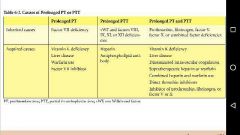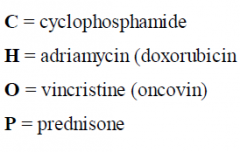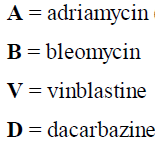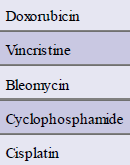![]()
![]()
![]()
Use LEFT and RIGHT arrow keys to navigate between flashcards;
Use UP and DOWN arrow keys to flip the card;
H to show hint;
A reads text to speech;
45 Cards in this Set
- Front
- Back
|
Autoimmune Hemolytic Anemia |
*Systemic disease (SLE, CLL) *Mycoplasma, drugs *Fatigue based on degree of anemia *Elevated indirect bilirubin, no bilirubin in urine< ALT normal *Coombs positive * Treat with steroids, cytotoxic agent; refractory cases--> splenectomy, IV immunoglobulins |
|
|
G6PD Deficiency |
* Acute oxidant stress * Elevated indirect bilirubin, no bilirubin in urine, ALT normal * Negative Coombs test * Bite cells, Heinz bodies |
|
|
ITP |
* Epistaxis, petechiae, purpura, +/- DI/CNS bleeding * Low platelet count * Normal-sized spleen * Positive antiplatelet antibodies * Increased megacariocytes on bone marrow |
|
|
ITP Treatment |
1. Steroids (prednisone or dexamethasone for 4-6 wks, followed by gradual taper): -- Only use in patients with counts <50,000/mm who are at high risk for bleeding 2. IV gammaglobulin (IgG) if acute increase in platalet counts are required with severe bleeding 3. Splenectomy for reccurent disease 4. Subsequent trestments: -- Danazol or cytotoxic agent 5. Platelet transfusions reserved for acute, unresponsive bleeding |
|
|
Syntetic trombopoetins for ITP |
* Romiplostim * Eltrombopag |
|
|
Von Willebrand Disease |
* Platelet-type bleeding * Normal platelet count * Prolonged bleeding time, decreased vWF levels, +/- prolonged PTT * Ristocetin cofactor assay Treat with DDAVP or Factor VIII replacement |
|
|
DIC |
* Both platelet-type and clotting-factor type bleeding * Usually with other major disease * Elevated PT and PTT * Low platelets, Positive D-dimer, Elevated fibrin split products, and low fibrinogen levels Treat with FFP +/- platelets transfusion Treat primary disease |
|
|
SSD Treatment Plan |
1. Agressive pain management with narcotic analgesics 2. Hydration 3. Oxygen 4. Antibiotics (cefotaxime or ceftriaxone) if there is fever or leukocytosis 5. Exchange transfusion if the hypoxia does not correct with supportive measures 6. Hydroxyurea to decrease frequency of crisis in the future 7. Pneumococcal vaccine 8. Chronic folate supplementation |
|
|
Vitamin K Deficiency |
* Decreased intake of green, leafy vegetables OR * Eradication of flora with antibiotics * Elevated PT first, then PTT * Normal platelets Replace vit K PO, SQ, or IV |
|
|
Factor Deficiency |
* Usually just an elevation of either PT or PTT * Mixing study corrects PT if deficiency; remains abnormal if inhibitor is present * Factor XI deficiency - elevated PPT, normal PT, Askenazic Jews |
|
|
Russell viper venom test |
* Performed after Mixing study is abnormal * If abnormal --> LAB fenomen |
|
|
Factor Inhibitor |
* History of frequent factors VIII or IX replasement * Elevated PTT +/- PT * Mixing studies do NOT correct * Specific antibody testing required * Overcome with high-volume factor replacement * Suppress antibody inhibitor with steroids |
|
|
Lupus Anticoagulant Anticardiolipin Antibodies |
* History of autoimmune disease, HIV infectiion * No bleeding; thrombophilia * Recurrent DVT, PE, spontaneous abortion * False + VDRL and false elevated PTT --> just markers for disease * Arterial and venus trombosis * Bleeding time and platelet count normal * Russell viper venom test prolonged - No treatment if asymptomatic; - Otherwise warfarin to target INR of 2-3 |
|
|
Major Blood Group Incompatibility |
* Usually a clerical error with immidiate, severe, and life-threatening reaction * Hypotension, dyspnea, back pain * Elevated indirect bilirubin; positive Coombs test; fragmented red cells on peripheral smear * Hemoglobin in urine; free hemoglobin in plasma; low haptoglobin; elevated LDH -- Stop transfusion; start hydration, mannitol |
|
|
Anaphylaxis Secondary to IgA Deficiency |
* Dyspnea, bronchospasm, hypotension after only a few milliliters of transfusion given * Reaction to donor IgA * No hemolysis -- Give Epi; steroids if severe -- Use IgA-deficient plasma and washed RBCs |
|
|
Febrile Nonhemolitic Transfusion Reaction |
* Fever, rigors, and chills with transfusion * Caused by reacting to antigens or donor WBCs * No hemolisis, bronchospasm, dyspnea, or urticaria -- Give acetaminophen acutely -- Used leukocyte-reduced, filtered blood to prevent |
|
|
Multiple Myeloma |
* Bone pain from fractures * Monoclonal spike in IgG or IgA * Bence Jones protein in urine * Anemia and renal falure * Plasma cells >30% bone merrow biopsy |
|
|
Multiple Myeloma tests & treatment |
-- Best initial test --> Serum protein electrophoresis (SPEP) -- Bone marrow biopsy confirm the diagnosis -- Bone scan shows nothing (good for blastic activity, MM is litic ) The Best innitial therapy: Thalidomide and steroids After --> control disease with allogenic bone marrow transplant most common cause of death of MM is infection |
|
|
Monoclonal Gammopathy of Undetermined Sygnificance |
* Monoclonal spike without any of above findings * No specific therapy * Monitor for progression to multiple myeloma |
|
|
Coagulopathy Prolonged PT or PTT |

|
|
|
Think about bone marrow abnormality if you see: |
-- progressive fatigue -- frequent infections -- easy bruisability -- heavy periods -- B12 or folate deficiency -- HIV |
|
|
Vit B12 or Folate Deficiency |
* For B12 deficiency: -- low serum levels of vitamin -- elevated methylamonic acid * For Folate deficiency: -- normal methylamonic acid -- elevated homocysteine level |
|
|
Myelofibrosis |
* Patients over 50; splenomegalia * Low, normal or increased WBC count * Numerous teardrop cells on smear * Marrow with increased reticulin fibers * No specific therapy - Talidomide and lenalidomide increase bone marrow production; - Ruxolitinib inhibits JAK2 and suppresses myelofibroses |
|
|
Beta Thalassemia Minor |
* Asymptomatic or with mild microcytic anemia * Profoundly low MCV with NO symptoms * Increased RBC number, normal RDW, target cells; normal iron studies * Definitive diagnosis with hemoglobin electrophoresis: -- increased Hb A2 and Hb F |
|
|
Alpha Thalassemia Trait |
* identical presentation to Beta Thalassemia * Hb electrophoresis NORMAL |
|
|
Sideroblastic Anemia |
* Usually from toxin ingestion, most commonly alcohol, rarely lead * Microcytic, hypochromic anemia * Normal ferritin * Increased serum iron level * Diagnose with Prussian-blue stain * Some respond to vit B6 replacement |
|
|
Iron Deficiency Anemia |
* Increased blood loss leading to iron store depletio * Microcytic anemia with decreased RBC number; elevated RDW; low reticulocyte count * Low ferritin, low iron, increased TIBC * Treatment is to replace iron |
|
|
Confirmation of Diagnosis CLL |
Lymph node biopsy
(not Bone marrow biopsy) |
|
|
Acute Monocytic Leukemia |
-- headaches -- fever -- weight loss -- bleeding from the gums or nose -- occasional skin lesions * Peripheral smear reveals leukocytosis with high proportion of blast forms * Alpha-naphthyl esterase positive and is characteristic |
|
|
CML |
* High WBC count and normal appearing neutrophils * Philadelphia chromosome and BCR/ABL positive * Treat with imatinib * BMT is curative |
|
|
CLL |
* Eldery * High WBC is all lymphocytes * Normal smear exept "smudge cells" Treat with Fludarabine or Chlorambucil |
|
|
Richter phenomenon |
Conversion of CLL into high-grade lymphoma (in 5% of patients) |
|
|
Hairy Cell Leukemia |
-- Limphocytes have fine, hair-like, irregular projections -- Bone marrow may become fibrotic -- Cytochemical feature includes a tartrate-resistant acid phosphatase (TRAP) stain Treat with Cladribine or Pentostatin its adverse effects include neurological and kidney damage |
|
|
Epsilon amino caproic acid |
* Substance that inhibits fibrinolisis * Used in DIC to increase dissolution of fibrin |
|
|
Aquired storage pool disorder |
Uremia makes platelets non-functional Give DDAVP |
|
|
HIT The most accurate test |
Platelet factor four antibodies |
|
|
Which mexhanism of HUS |
Decrease in ADAMTS 13 |
|
|
Best initial therapy in HUS and TTP |
* Miled disease -- No tretment ** Severe -- FFP or plasmapharesis |
|
|
Paroxysmal Nocturnal Hemoglobinuria Diagnostic Tests |
-- Decay accelerating factor (CD55 and CD59) -- Ham test -- Flow cytometry |
|
|
Paroxysmal Nocturnal Hemoglobinuria Treatment |
1. Prednison 2. Allogenic bone marrow transplant (cure) 3. Eculizumab - for hemolysis and thrombosis 4. Folic acid and transfusion as needed |
|
|
Tested facts for Acute Leukemias: |

|
|
|
NHL Treatment |

|
|
|
HL Treatment |

|
|

|

|
|
|
Wandenstrom Macroglobulinemia |
* Overproduction of IgM from malignant B cells leading to hyperviscosity Presents with: - Lethargy - Blurry vision and vertigo - Endorged blood vessels in the eye - Mucosal bleeding - Raynaud phenomenon * Plasmapheresis - best initial therapy * Rituximab or prednisone - long-term * Bortezonib or lenalidomide - lower productions of cells |

